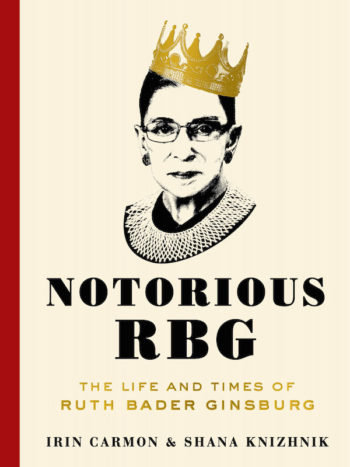You down with RBG? Highlights from the new biography of Ruth Bader Ginsburg
Published November 5, 2015

Ruth Bader Ginsburg speaking at the University of Michigan in Ann Arbor, Feb. 6, 2015. (Carlos Osorio/AP Images)
(JTA) — Ever wonder what the perfect pop-culture storm looks like?
Hurricane Ruth — as in Bader Ginsburg — was brewing among millennials, feminists and across social media platforms before it made landfall in Irin Carmon and Shana Knizhnik’s new biography about the Meme Supreme: “Notorious RBG: The Life and Times of Ruth Bader Ginsburg” (Dey Street Books/Harper Collins).
Just in time for Hanukkah wish lists, the new biography explores what Carmon in a recent New York Times Op-Ed calls the “cautious radicalism” of the formidable Brooklyn-raised justice, the first Jewish woman to wear a Supreme Court robe and the second woman overall.
For readers it’s a rare pleasure when serious fun and serious history come together between two covers. “Notorious RBG” is chatty and candid, erudite and expansive.
The Notorious RBG phenomenon grew out of a blog started in 2013 by Knizhnik, a lawyer, when she was a law student at New York University. Knizhnik was devastated by Shelby County v. Holder and its evisceration of the Voting Rights Act. The bright spot for Knizhnik, however, “was the unfettered rage of Justice Ginsburg.”
When a friend made a Facebook comment about “the Notorious RBG,” Knizhnik had her a-ha moment, creating her Tumblr, a blog where the stylistic trappings of a very different Brooklyn-born celebrity — the late rapper Notorious B.I.G. — would follow other RBG memes with abandon, from “Fear the Frill” to “There’s No Ruth Without Truth.”
READ: ‘Broad City’ pays homage to Ruth Bader Ginsburg and Judge Judy
In this new biography — reported and researched with Carmon, a journalist — those who relish the story behind the story will find in “Notorious RBG” journalistic heft, historical weight and judicial context, but it’s made super accessible with colorful cartoons, memes and tattoos.
The book “might as well be subtitled ‘biography of a bad-ass,’” says The New Yorker’s Jeffrey Toobin (author of “The Nine”) in a teaser for a Nov. 5 conversation he will moderate in New York, part of a heavy-hitting book tour that includes the National Press Club Book Fair.

The cover of “Notorious RBG: The Life and Times of Ruth Bader Ginsburg.” (HarperCollins)
With RBG love at an all-time high, this biography is a fun must-read that provides a cultural history of the pop culture surrounding an unlikely icon — plus an insidery look at how RBG handled her own work-life balance, all while helping bring greater equality to more Americans (hint: she doesn’t sleep).
Until you get your own copy, read on for the seven top takeaways from the book.
Notorious RBG isn’t her first nickname.
First, she was Kiki, a childhood nickname Ginsburg acquired from her big sister. Later, at Camp Che-Na-Wah in the Adirondacks, she “acquired the title of camp rabbi,” according to the book. NPR’s Nina Totenberg has called her the “architect of the legal strategy of the women’s movement” — but Kiki more easily rolls off the tongue.
She didn’t just succeed in law, she succeeded in love.
Ginsburg married her “bashert.” She has referred to her husband, Marty Ginsburg, as her “life partner” and “best friend.” Their union lasted from their wedding in 1954 to his death from metastatic cancer in 2010. Their union took place just days after Kiki’s graduation — first in her class — from Cornell: “There were 18 people present, because in Judaism that number symbolizes life,” Carmon writes.
Her trainer calls her TAN — that’s shorthand for “tough as nails.”
“A lot of people throw around the word unstoppable when they talk about RBG. But they should know that it is literally true,” Carmon writes. “Like the time the justice had a cracked rib, which wasn’t about to stop her from keeping her twice-weekly personal training session.” According to her trainer of nearly two decades, “she works just as hard in the gym as she does on the bench.”
READ: Ginsburg officiates at same-sex wedding, a first for a Supreme Court justice
Is there anyone else in the universe who’s as bold and demure?
During the 2012-13 term, RBG read five dissents from the bench, breaking “a half-century-long record among all justices. Her dissent in the voting rights case was the last and most furious.” Reading a dissent from the bench is rare — it’s a way to shout the fact (with decorum) that you find a ruling utterly reprehensible. “Like pulling a fire alarm,” Carmon writes. Ginsburg’s extremely well-worded outspokenness, paired with her steadfast commitment to civil rights, is one of the reasons she has inspired her own iconography and become a viral sensation.
Clothes may make the man, but RBG’s accessories make precedent.
“Look around her neck. When the jabot with the scalloped glass beads glitters flat against the top of RBG’s black robe, it’s bad news for liberals. That’s her dissent collar,” Carmon writes. (Yes, RBG’s choices in neckwear provide a visual clue to the court’s opinions.) Overall, Carmon describes her aesthetic as “precise, elegant, and at times, unexpectedly audacious.” Just like her opinions.
Justice, justice, thou shalt pursue.

A recent Ruth Bader Ginsburg poster. (Hallie Jay Pope)
This biblical injunction is inscribed on the wall of her chambers, and since her teens, RBG has noticed when the law — Jewish or constitutional — excluded women. When her mother died of cancer (the day before her daughter’s high school graduation), “at the house on East Ninth Street filled with mourning women, Kiki watched dully, because no woman counted for a minyan … Kiki herself did not count.” While it was Jewish law, Carmon writes, the experience “taught Kiki about a commitment to justice … after her mother died, it took a long time to see herself in the faith.”
She may be growing old, but she’s very much in the game.
A survivor of pancreatic and colon cancer, RBG remains relentless – in all things, including her commitment to the job. This particular bench has seniority seating: Justice Ginsburg sits third from right. That’s not a position she’s ready to give up, despite the near-constant conjecture. So far, she’s never missed a day. “RBG has her own metric for when it’s time to go. ‘When I forget the names of cases that I once could recite at the drop of a hat,’ she said, ‘I will know.’”
(Erica Brody is a writer, editor and strategist based in Brooklyn.)














